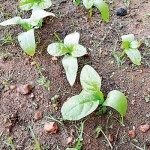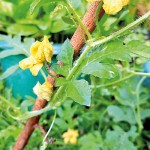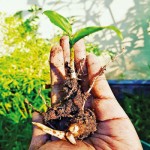Going green at home
A topic that often comes up these days is how to be self sufficient. When access to supplies were low and income was wavering, many tended to consider the topic. Gardening was one of the obvious options, and a trend has emerged since then for home gardens with gusto.
But how do you start a home garden? What can you grow, and how should you grow it? We spoke to a few home gardeners about what advice they had to give.
- Pix courtesy Nivanka Fernando
Most people suggested container gardening for beginners and people living in cities. It’s easier to control the moisture and nutrients when everything is potted. Tomatoes, garlic, chillies, okra aka bandakka, long beans aka ma karal and eggplant do well in pots. And since most of these are already in our vegetable baskets, it’s a matter of saving the seeds, soaking them in water, and planting the newly leafed out seedlings.
Other options are kankun and kottamalli. It’s easy to pot kottamalli and onions, but you’d have to find a patch if you plan to grow kankun. It pays off, however, since it grows fast and makes a very nourishing and filling dish for meals. You can also save roots like coriander, leeks, and use garlic cloves, bits of young ginger or accidentally sprouted potatoes and onions for planting.
Growing in bigger spaces
For those who have a lot of garden space, beans, melons, pumpkins, and cucumbers are also easy to start as well. As curfew regulations get relaxed, you might be able to try your luck and get seed packets with a high germination rate from a garden shop.
Speaking about the basic supplies needed for a home gardening project, those would be containers or a sunny patch of soil, a 50:50 compost and sand mixture, and commercial nitrogen fertilizer. But if you haven’t done gardening before, or planned to do so, even rich brown soil that you find at home works perfectly if you add some nutrients in it.
However, at present it’s more advisable to make your own compost or add things like banana peels, used tea leaves, and egg shells to the soil.
Aeration of soil
If you’re not going for pots and planning to cultivate a small vegetable garden making sure the soil is well dug is vital. If the soil isn’t dug up, the young seeds won’t be able to grow roots into the soil, and fresh air won’t be able to reach the soil and further aerate the plant.
A good pair of gloves, shears, and a gardening tool set are good supplements to have, but if you don’t happen to own any, your hands can do just as much, and old or dented cutlery can be pretty handy as well.
Choosing a good spot is essential because of the heat, wind, and heavy rain. Somewhere with shelter from storms and the harshest midday sun is ideal. But if you’re using pots, you can experiment with moving them around to see which spot gives the best results.
Keeping space between plants
When you’re planting, make sure to keep adequate space between plants, particularly vines like pumpkins. Remember that the seed you’re planting will grow into a full plant one day, and make sure it will have space to grow, and also enough soil to get water and nutrients from.
As the seedlings grow, two important things to remember is to not over moisturize, or over nutrition.
It might be tempting to water or compost the soil whenever you check up on the plants, but too much is also a bad thing. The additional intake can make your seedlings die out.






